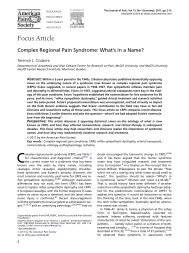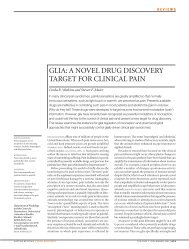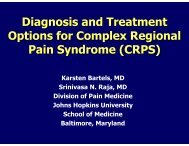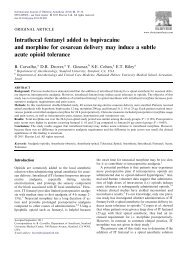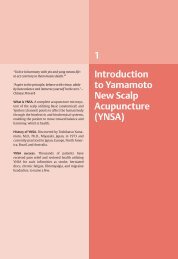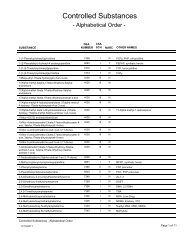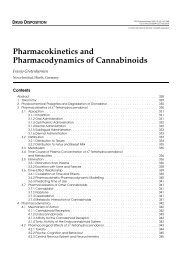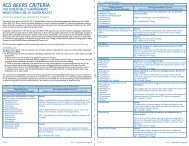1) Vitamin D For Chronic Pain - Pain Treatment Topics.org
1) Vitamin D For Chronic Pain - Pain Treatment Topics.org
1) Vitamin D For Chronic Pain - Pain Treatment Topics.org
You also want an ePaper? Increase the reach of your titles
YUMPU automatically turns print PDFs into web optimized ePapers that Google loves.
<strong>Vitamin</strong> D for <strong>Chronic</strong> <strong>Pain</strong><br />
TABLE 7. Drugs Potentially Interacting with<br />
<strong>Vitamin</strong> D<br />
Potency of vitamin D is reduced. The vitamin dose<br />
can be increased to accommodate this.<br />
• antacids (aluminum- or magnesium-containing)<br />
• anticonvulsants (eg, carbamazepine)<br />
• antirejection meds (after <strong>org</strong>an transplant)<br />
• antiretrovirals(HIV/AIDS therapies)<br />
• barbiturates (eg, phenobarbital, phenytoin)<br />
• cholestyramine<br />
• colestipol<br />
• corticosteroids<br />
• glucocorticoids<br />
• hydroxychloroquine<br />
• rifampin<br />
Risk of hypercalcemia when taken concurrently. Very<br />
high doses of vitamin D should be avoided.<br />
• digitalis/digoxin<br />
• thiazide diuretics<br />
References: Bringhurst et al 137 ; Calcitriol 12 ; Ergocalciferol 13 ;<br />
Holick 14 ; Hollis et al 124 ; Marcus 15 ; Mascarenhas and Mobarhan 51 ;<br />
ODS 133 ; Turner et al 60<br />
Disclosure<br />
The author reports no involvement in the nutritional supplement<br />
industry or any other conflicts of interest. Covidien/<br />
Mallinckrodt, St. Louis, MO, as a sponsor of <strong>Pain</strong> <strong>Treatment</strong><br />
<strong>Topics</strong>, provided educational funding support for the research<br />
report on <strong>Vitamin</strong> D but had no role in its conception or development.<br />
The sponsor has no vested interests in the nutritional<br />
supplement industry and is not a manufacturer or distributor<br />
of vitamin products.<br />
Stewart B. Leavitt, MA, PhD, is the founding Publisher/Editor of <strong>Pain</strong><br />
<strong>Treatment</strong> <strong>Topics</strong> and has more than 25 years of experience in healthcare<br />
education and medical communications serving numerous government<br />
agencies and other <strong>org</strong>anizations. He was educated in biomedical<br />
communications at the University of Illinois at Chicago College of<br />
Medicine and then served as a Commissioned Officer in the US Public<br />
Health Service at the National Institutes of Health. He went on to earn<br />
Masters and Doctorate degrees specializing in health/medical research<br />
and education at Northwestern University, Evanston, Illinois. He is a<br />
member of the American Academy of <strong>Pain</strong> Management and a founding<br />
member of the International Association for <strong>Pain</strong> & Chemical<br />
Dependency.<br />
References<br />
1. Mohr SB, Garland CF, Gorham ED, Garland FC. The association between ultraviolet<br />
B irradiance, vitamin D status and incidence rates of type 1 diabetes in 51<br />
regions worldwide. Diabetologia. Online publication ahead of print, June 12, 2008.<br />
2. Ng K, Meyerhardt JA, Wu K, et al. Circulating 25-hydroxyvitamin D levels and<br />
survival in patients with colorectal cancer. J Clin Oncol. 2008. 26(18):2984-2991.<br />
3. Giovannucci E, Liu Y, Hollis BW, Rimm EB. 25-hydroxyvitamin D and risk of<br />
myocardial infarction in men. Arch Int Med. 2008. 168(11):1174-1180.<br />
4. APF (American <strong>Pain</strong> Foundation). <strong>Pain</strong> facts: overview of American pain surveys.<br />
2007. Available online at: http://www.painfoundation.<strong>org</strong>/page.aspfile=Newsroom/<br />
<strong>Pain</strong>Surveys.htm. Accessed 2/25/08.<br />
5. Nachemson A, Waddell G, Norlund A. Epidemiology of neck and back pain. In:<br />
Nachemson A, Jonsson E (eds) Neck and Back <strong>Pain</strong>: the Scientific Evidence of<br />
Causes, Diagnosis, and <strong>Treatment</strong>. Phila, PA: Williams & Wilkins; 2000: 165-188.<br />
6. NPF (National <strong>Pain</strong> Foundation). Harris Interactive Survey on <strong>Pain</strong> in America, Dec<br />
2007. Released in 2008. Avail at: http://www.nationalpainfoundation.<strong>org</strong>/<br />
MyResearch/<strong>Pain</strong>Survey2008.asp. Accessed 2/25/08.<br />
7. Watkins EA, Wollan PC, Melton III J, Yawn PB. A population in pain: report from<br />
the Olmsted County Health Study. <strong>Pain</strong> Med. 2008. 9(2):166-174.<br />
8. Deyo RA. Diagnostic evaluation of LBP. Arch Intern Med. 2002. 162:1444-1448.<br />
9. Deyo RA, Weinstein JN. Low back pain. New Eng J Med. 2001. 344:363-370.<br />
10. Holick MF. <strong>Vitamin</strong> D for health and in chronic kidney disease. Semin Dial. 2005.<br />
18:266-275.<br />
11. Lau AH, How PP. The role of the pharmacist in the identification and management<br />
of secondary hyperparathyroidism. US Pharmacist. 2007(Jul):62-70. Avail at:<br />
http://www.uspharmacist.com/index.asppage=ce/105514/default.htm. Accessed<br />
2/15/08.<br />
12. Calcitriol. Merck Manual [online]. 2007. Avail at: http://www.merck.com/<br />
mmpe/lexicomp/calcitriol.html. Accessed 2/19/08.<br />
13. Ergocalciferol. Merck Manual [online]. 2007. Avail at: http://www.merck.com/<br />
mmpe/lexicomp/ergocalciferol.html. Accessed 2/19/08.<br />
14. Holick MF. <strong>Vitamin</strong> D deficiency. N Engl J Med. 2007. 357(3):266-281.<br />
15. Marcus R. Agents affecting calcification and bone turnover: calcium, phosphate,<br />
parathyroid hormine, vitamin D, calcitonin, and other compounds. Chap 61. In:<br />
Hardman JG, Limbird LE, eds. Goodman & Gilman’s The Pharmacological Basis of<br />
Therapeutics. 9th ed. New York, NY: McGraw-Hill; 1995.<br />
16. ODS (Office of Dietary Supplements; US National Institutes of Health). Dietary<br />
Supplement Fact Sheet: <strong>Vitamin</strong> D. Updated Feb 19, 2008. Avail at: http://dietarysupplements.info.nih.gov/<br />
factsheets/vitamind.asp. Accessed 4/27/08<br />
17. Singh YN. <strong>Vitamin</strong> D. Part I: Are we getting enough US Pharm. 2004a. 10:66-72.<br />
Avail at: http://www.uspharmacist.com/index.aspshow=article&page=<br />
8_1352.htm. Accessed 4/29/08.<br />
18. Tavera-Mendoza LE, White JH. Cell defenses and the sunshine vitamin. Scientific<br />
American. Nov 2007. Avail at: http://www.sciam.com/article.cfm id=celldefenses-and-the-sunshine-vitamin.<br />
Accessed 3/1/08.<br />
19. Vieth R. The pharmacology of vitamin D, including fortification strategies.<br />
Chapter 61. In: Feldman D, Glorieux F, eds. <strong>Vitamin</strong> D. 2nd ed. Boston, MA: Elsevier<br />
Academic Press; 2005. Avail at: http://www.directms.<strong>org</strong>/pdf/VitDVieth/Vieth%20chapter<br />
%2061.pdf. Accessed 4/17/08.<br />
20. Johnson LE. <strong>Vitamin</strong> D. Merck Manual [online]. 2007. Avail at:<br />
http://www.merck.com/mmpe/<br />
sec01/ch004/ch004k.htmlqt=vitamin%20D&alt=sh#tb004_6. Accessed 2/19/08.<br />
21. Lips P. <strong>Vitamin</strong> D deficiency and secondary hyperparathyroidism in the elderly:<br />
consequences for bone loss and fractures and therapeutic implications. Endocrine<br />
Rev. 2001. 22(4):477-501.<br />
22. Reginster J-Y. The high prevalence of inadequate serum vitamin D levels and<br />
implications for bone health. Curr Med Res Opin. 2005. 21(4):579-585. Avail at:<br />
http://www.medscape.com/viewarticle/504783_ print. Accessed 2/24/08.<br />
23. Holick MF, Biancuzzo RM, Chen TC, et al. <strong>Vitamin</strong> D2 is as effective as vitamin<br />
D3 in maintaining circulating concentrations of 25-hydroxyvitamin D. J Clin<br />
Endocrinol Metab. 2008. 93(3):677-687.<br />
24. Vieth R. <strong>Vitamin</strong> D supplementation, 25-hydroxyvitamin D concentrations, and<br />
safety. Am J Clin Nutr. 1999. 69:842-856.<br />
25. Hollis BW. Circulating 25-hydroxyvitamin D levels indicative of vitamin D sufficiency:<br />
implications for establishing a new effective dietary intake recommendation<br />
for vitamin D. J Nutr. 2005. 135:317-322. Available by search at:<br />
http://jn.nutrition.<strong>org</strong>/search.dtl. Accessed 4/2/08.<br />
26. Vieth R, Chan P-CR, MacFarlane GD. Efficacy and safety of vitamin D3 intake<br />
exceeding the lowest observed adverse effect level. Am J Clin Nutr. 2001:73: 288-294.<br />
Avail at: http://www.ajcn.<strong>org</strong>/cgi/content/full/73/2/288.<br />
27. Shinchuk L, Holick MF. <strong>Vitamin</strong> D and rehabilitation: improving functional<br />
outcomes. Nutr Clin Prac. 2007. 22(3):297-304.<br />
28. Holick MF. <strong>Vitamin</strong> D: the underappreciated D-lightful hormone that is important<br />
for skeletal and cellular health. Curr Opin Endocrinol Diabetes. 2002b;9:87-98.<br />
29. Holick MF, Chen TC. <strong>Vitamin</strong> D deficiency: a worldwide problem and health<br />
consequences. Am J Clin Nutr. 2008. 87(suppl):1080S-1086S.<br />
30. Marshall TG. <strong>Vitamin</strong> D discovery outpaces FDA decision making. Bioessays.<br />
2008. 30(2):173-182.<br />
31. Walters MR. Newly identified actions of the vitamin D endocrine system. Endocrine<br />
Rev. 1992. 13(4):719-764.<br />
32. Kawaguchi Y, Kanamori M, Ishihara H, et al. The association of lumbar disc<br />
disease and vitamin-D receptor gene polymorphism. J Bone Joint Surg Am. 2002.<br />
84-A(11):2022-2028.<br />
33. Videman T, Gibbons LE, Battie MC, et al. The relative roles of intragenic<br />
polymorphisms of the vitamin D receptor gene in lumbar spine degeneration and<br />
bone density. Spine. 2001. 26(3):A1-A6.<br />
34. Grant WB. An estimate of premature cancer mortality in the U.S. due to inadequate<br />
doses of solar ultraviolet-B radiation. Cancer. 2002. 94:1867-1875.<br />
35. Holick MF. <strong>Vitamin</strong> D: a millenium perspective. J Cell Biochem. 2003a. 88:296-<br />
307.<br />
36. Holick MF. <strong>Vitamin</strong> D: photobiology, metabolism, mechanism of action, and clinical<br />
applications. In: Favus MJ, ed. Primer on the Metabolic Bone Diseases and<br />
40 Practical PAIN MANAGEMENT, July/August 2008<br />
©2008 PPM Communications, Inc. Reprinted with permission.



